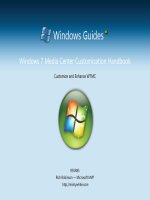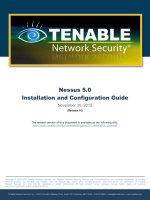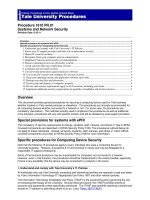Computers and Digital Basics pot
Bạn đang xem bản rút gọn của tài liệu. Xem và tải ngay bản đầy đủ của tài liệu tại đây (827.09 KB, 37 trang )
Computers and Digital Basics
Computers and Digital Basics
Chapter 1
Chapter 1
1
Chapter 1: Computers and Digital Basics 2
Chapter Contents
Section B: Digital Devices
Section C: Digital Data Representation
Section D: Digital Processing
Section E: Password Security
1
SECTION
B
Chapter 1: Computers and Digital Basics 3
Digital Devices
Digital Devices
Computer Basics
Personal Computers, Servers, Mainframes,
and Supercomputers
PDAs, Portable Players, and Smart Phones
Microcontrollers
1
Chapter 1: Computers and Digital Basics 4
Computer Basics
A computer is a multipurpose device that accepts input,
processes data, stores data, and produces output, all
according to a series of stored instructions
1
Chapter 1: Computers and Digital Basics 5
Computer Basics
Computer input is whatever is typed,
submitted, or transmitted to a computer
system
Output is the result produced by a
computer
Data refers to the symbols that represent
facts, objects, and ideas
Computers manipulate data in many
ways, and this manipulation is called
processing
–
Central Processing Unit (CPU)
–
Microprocessor
1
Chapter 1: Computers and Digital Basics 6
Computer Basics
Memory is an area of a computer that temporarily
holds data waiting to be processed, stored, or
output
Storage is the area where data can be left on a
permanent basis when it is not immediately needed
for processing
A file is a named collection of data that exists on a
storage medium
The series of instructions that tells a computer how
to carry out processing tasks is referred to as a
computer program
–
Software
1
Chapter 1: Computers and Digital Basics 7
Computer Basics
A stored program means that a series of
instructions for a computing task can be
loaded into a computer’s memory
–
Allows you to switch between tasks
–
Distinguishes a computer from other simpler
devices
1
Chapter 1: Computers and Digital Basics 8
Computer Basics
Application software is a set of computer
programs that helps a person carry out a task
The primary purpose of system software is to
help the computer system monitor itself in
order to function efficiently
–
Operating system (OS)
1
Chapter 1: Computers and Digital Basics 9
Personal Computers, Servers,
Mainframes, and Supercomputers
A personal computer is a microprocessor-
based computing device designed to meet
the computing needs of an individual
1
Chapter 1: Computers and Digital Basics 10
Personal Computers, Servers,
Mainframes, and Supercomputers
The term workstation has two meanings:
–
An ordinary personal computer that is connected
to a network
–
A powerful desktop computer used for high-
performance tasks
1
Chapter 1: Computers and Digital Basics 11
Example: Workstation Computer
/>1
Chapter 1: Computers and Digital Basics 12
Personal Computers, Servers,
Mainframes, and Supercomputers
A videogame console, such as
Nintendo’s Wii, Sony’s PlayStation,
or Microsoft’s Xbox, are not
generally referred to as personal
computers because of their history
as
dedicated game devices
1
Chapter 1: Computers and Digital Basics 13
Personal Computers, Servers,
Mainframes, and Supercomputers
The purpose of a server is to serve computers on a network
(such as the Internet or a home network) by supplying them
with data
A mainframe computer (or simply a mainframe) is a large
and expensive computer capable of simultaneously
processing data for hundreds or thousands of users
A computer falls into the supercomputer category if it is, at
the time of construction, one of the fastest computers in the
world
–
A compute-intensive problem is one that requires massive amounts
of data to be processed using complex mathematical calculations
1
Chapter 1: Computers and Digital Basics 14
Personal Computers, Servers,
Mainframes, and Supercomputers
1
Chapter 1: Computers and Digital Basics 15
The Digital Revolution
A computer network is a group of computers linked
by wired or wireless technology to share data and
resources
The Web is a collection of linked documents,
graphics, and sounds that can be accessed over the
Internet
Cyberspace is a term that refers to entities that exist
largely within computer networks
1
Chapter 1: Computers and Digital Basics 16
PDAs, Portable Players,
and Smart Phones
A PDA (personal digital assistant) is a pocket-sized digital
appointment book with a small qwerty keyboard or a touch-
sensitive screen, designed to run on batteries and be used
while holding it
A handheld computer is essentially a PDA enhanced with
features such as removable storage, e-mail, Web access, voice
communications, built-in camera, and GPS
A smart phone, which in addition to voice communication,
includes features such as full qwerty keypad, text messaging,
e-mail, Web access, removable storage, camera, FM radio,
digital music player, and software options for games, financial
management, personal organizer, GPS, and maps
iPods and similar devices are classified as portable media
players because their main strength is playing music, showing
videos, and storing photos
1
Chapter 1: Computers and Digital Basics 17
PDAs, Portable Players,
and Smart Phones
1
Chapter 1: Computers and Digital Basics 18
Microcontrollers
A microcontroller is a special-purpose
microprocessor that is built into the machine
it controls
Microcontrollers can be embedded in all sorts
of everyday devices
1
SECTION
C
Chapter 1: Computers and Digital Basics 19
Digital Data Representation
Digital Data Representation
Data Representation Basics
Representing Numbers, Text, and Pictures
Quantifying Bits and Bytes
Circuits and Chips
1
Chapter 1: Computers and Digital Basics 20
Data Representation
Data representation refers to the form in which
data is stored, processed, and transmitted
Digital devices work with distinct and separate
data
Analog devices work with continuous data
1
Chapter 1: Computers and Digital Basics 21
Representing Numbers, Text,
and Pictures
Numeric data
–
Binary number system
Character data
–
ASCII, Extended ASCII,
EBCDIC, and Unicode
Digitizing is the
process of converting
analog data into digital
format
1
Chapter 1: Computers and Digital Basics 22
Example: Binary Representation
Representing data with binary values has
been around for a long time. For example,
Morse code uses a series of short and long
signals to represent values.
/>1
Chapter 1: Computers and Digital Basics 23
Data Representation
1
Chapter 1: Computers and Digital Basics 24
Quantifying Bits and Bytes
1
SECTION
D
Chapter 1: Computers and Digital Basics 25
Digital Processing
Digital Processing
Programs and Instruction Sets
Processor Logic









